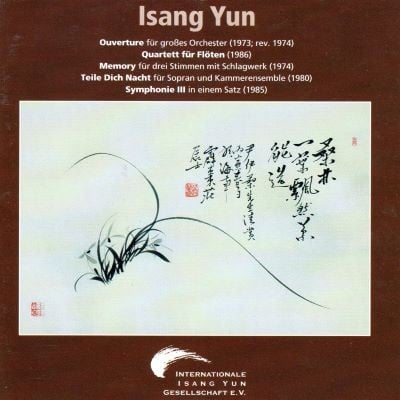perc(to be played by singers):table bell/cyms/claves/tpl.bl/crot/hyoshigi/2maracas/tgl
Abbreviations (PDF)
Bote & Bock
Although Memory is in harmony with Yun’s complete oeuvre in terms of sound, expression, and form, its peculiar instrumentation, experimental notation, and predominantly quiet dynamics mean that it occupies a special place within this context. Even though at first glance the notation, as far as pitches and rhythm are concerned, may not appear to be very precisely determined in all its details, it is nevertheless precise enough so that only a little free room remains for the interpreter. The parts are written without key signatures but nonetheless notated on five lines, and relatively precise prescriptions hold for the diverse gradings between singing and speaking (from noise-like whispering to half-spoken, half-sung singing and then to pure singing). In addition, there are graphic symbols for the lowest and highest tones of the particular part, for falsetto, noise-like articulation as well as "almost voiceless, dry, and short." The singers are to employ the most atonal intervals possible and to avoid note constellations on the same pitch. The temporal course is divided by measure bars, and the duration of each "measure" is set at four seconds. A number of percussion instruments are to be played by the singers: table bells, a hanging cymbal, temple blocks, crotales, hyoshigi, two maracas, triangles.
The author of the text, who has not yet been identified precisely, may have been Du Mu (also: Tu Mu, 803-852). In an introduction to the work issued by Yun for its premiere, we read, "The lament poem ‘Epitaph’ by Du-Mok (China, late Tang dynasty, ninth century) serves as the textual source. The poet mourns at the grave of his friend while devoting his thoughts to the transitoriness of life in a melancholy natural setting. The four-verse poem is by and large inserted into a different context in the composition and combined in different ways. Together with the poetic context the phonetic charms of the words, which are presented in Sino-Korean pronunciation, are employed as acoustical material. The declamatory line, the word components, and the different nuances produced by vocal articulation styles — far, near, clear, clouded, shallow, deep — are elements forming and coloring the piece. The percussion instruments (high metal and wood percussion instruments) employed by the three interpreters are supposed to make the natural setting transparent."
For Memory Yun varied an idea that he had tried out for the first time in Gagok for voice, guitar, and percussion (1972). He reinforces the vocal part, bringing it out more so than in Gagok, while reducing the instrumental accompaniment. Stylistically, Yun also draws on Old Korean song genres in Memory. A slow recital tempo is characteristic of the vocal style of this courtly-aristocratic tradition, with the individual text syllables being long-drawn-out and extended melismatically. The aestheticization of the singing goes so far in the interest of harmoniousness that the syllables are even split up into their vocal components.
Memory exhibits a symmetrical design, but Yun again immediately relativizes its precision with imaginative deviations. On the whole, the composition has two corresponding parts separated by a rest measure with the instruction "standing completely still." Each of the two parts can be divided into three larger sections. In the first part two strophes follow a noise-like introduction. The second part is divided into three strophes. The five strophes are separated from each other by instrumental interludes (except in the case of the transition between the second and third strophes, which is regulated by a general rest). It is thus that here a form derived from the Old Korean kagok song genre is once again produced. The text of a tan’ga poem (three verses of fifteen syllables each) is assigned to five musical sections (chang). After the third chang an instrumental interlude (chungyôûm) is heard. The fourth chang contains only three syllables and brings the "turn" to the poetic climax.
After a quiet and noise-like beginning ("produce the wind noise ‘sh’ through half-whistling") accompanied by the table bells, Voice I (soprano, in the middle range) enters to the first song, extended and still half-spoken, to the musical recitation of the syllables "Go in bun ssu rip." The voice parts are presented in succession: only Voices II and III coincide for a short time. A "little temple-block concerto" functions as the instrumental interlude to the second strophe, in which the voices, beginning from low ranges, act first in forte and then together.
Vocalist III begins the very short third strophe with an "intonation as in stuttering" and then "with beautiful tone." A little crotales concerto concludes this opening of the second part. The fourth strophe, extended over three phrases, appears as the high point; here the voice parts initially blend together completely in tone color "with gradually increasing vibrato" on the recitation of the vowel u. The entry of the hyÜshigi wooden percussion idiophones together with the claves and temple blocks energetically impels the flow forward in a vehement forte ("intensively holding the long-drawn-out tones"). The unity of the parts is again destabilized in the third phase. Sounds of the temple blocks, two maracas, and a pounding of the cymbal form a transition to the first strophe, in which the musicians continuously both sing and accompany themselves on their instruments.
Walter-Wolfgang Sparrer (2001, translated by Susan Marie Praeder)

Gisela Saur-Kontarsky, Carla Henius, William Pearson
Internationale Isang Yun Gesellschaft IYG 002
